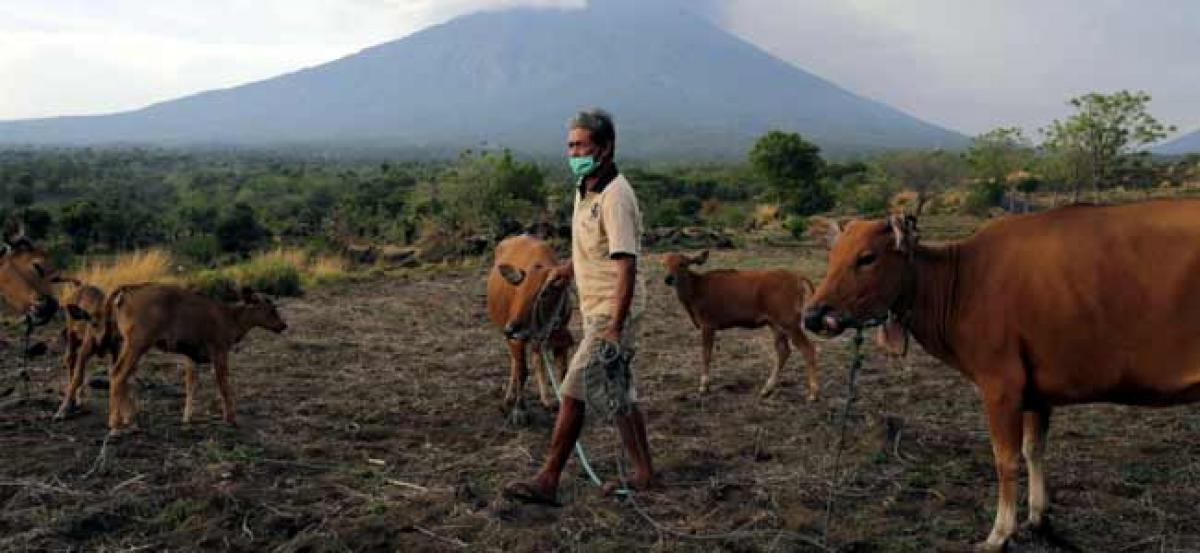Live
- G20 Leaders Will Talk About Climate, Taxes, and Trump's Return in Brazil
- COP29: CDRI announces $8 million funding for 12 projects to address climate crisis
- Anti-Telgu remarks: Actor Kasthuri Shankar moves court for bail
- Samsung AR Smart Glasses Set to Launch in 2025, Featuring Ray-Ban Meta-Like Design
- Kerala Industries Minister confident that new policy will boost plantation sector
- Madras HC plans inter-departmental monitoring committee to combat drug use in TN
- Bihar: Spotted deer dies due to heart attack in Banka district
- Mushtaq Ali T20: Shami to spearhead Bengal bowling attack, Gharami named captain
- Kharge's clarion call to oust Maharashtra's BJP-backed MahaYuti
- Why Ukraine’s Use of US Missiles Against Russia Could Lead to World War 3
Just In

Indonesia on Tuesday extended the closure of the airport on Bali as ash from a volcano swept the island, stranding thousands of tourists as authorities tried to persuade villagers to leave their homes near the erupting mountain.
KARANGASEM, Indonesia: Indonesia on Tuesday extended the closure of the airport on Bali as ash from a volcano swept the island, stranding thousands of tourists as authorities tried to persuade villagers to leave their homes near the erupting mountain.
“Aircraft flight channels are covered with volcanic ash,” the transport ministry said in a statement, citing aviation navigation authorities.
Bali’s airport, about 60 km (37 miles) from the Mount Agung volcano, will be closed until 7 a.m. on Wednesday (2300 GMT on Tuesday), it said.
Frustration at the country’s second-busiest airport were starting to boil over, with an estimated 2,000 people attempting to get refunds and reschedule tickets.
“There are thousands of people stranded here at the airport,” said Nitin Sheth, a tourist from India.
“They have to go to some other airport and they are trying to do that, but the government or authorities here are not helping.”
Others were more relaxed.
“No, there’s not a lot of information ... very little. (But) it’s all right. We’re on holidays so it doesn’t matter. We don’t know what’s going to happen but we can get back to the bar and have another drink,” said Matthew Radix from Perth.
Ten alternative airports have been prepared for airlines to divert inbound flights, including in neighbouring provinces, the airport operator said, adding it was helping people make alternative bookings and providing food and entertainment for stranded travellers.
The airport on Lombok island, to the east of Bali, had been reopened, authorities said, as wind blew ash westward, toward the southern coast of Java island.
PRAYERS
Agung towers over eastern Bali to a height of just over 3,000 metres (9,800 feet). Its last eruption in 1963 killed more than 1,000 people and razed several villages when it spewed out pyroclastic material, hot ash, lava and lahar.
On Tuesday, however, life went on largely as normal in villages surrounding Agung, with residents offering prayers as the volcano sent columns of ash and smoke into the sky.
Some villagers who fled in September, when the alert was last raised to the highest level, have gone home despite government warnings.
On Monday, authorities said 100,000 residents living near the volcano had been ordered to get out of an 8-10 km (5-6 mile) exclusion zone, warning a larger eruption was “imminent”.
While the population in the area has been estimated at anywhere between 63,000 and 140,000, just over 29,000 people were registered at emergency centres, said Sutopo Purwo Nugroho, a spokesman for the Disaster Mitigation Agency.
“Not all people in the danger zone are prepared to take refuge,” he said.
“There are still a lot of residents staying in their homes.”
Indonesia’s Volcanology and Geological Disaster Mitigation Centre has warned that an eruption of a size similar to that seen in 1963 could send rocks bigger than a fist flying a distance of up to 8 km (5 miles), and volcanic gas a distance of 10 km (6 miles) within three minutes.
Monitoring has shown the northeastern part of Agung’s peak had swollen in recent weeks “indicating there is fairly strong pressure toward the surface”, the centre said.
Despite a similar pattern of volcanic activity to that in 1963, which reached a peak after up to three months of ash emissions, it was not clear how long the current eruption would last, said David Pyle, a professor in earth sciences at Oxford University.
“It remains possible that the eruptive crisis could continue for some time.”

© 2024 Hyderabad Media House Limited/The Hans India. All rights reserved. Powered by hocalwire.com







